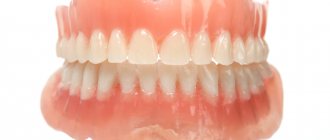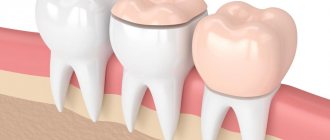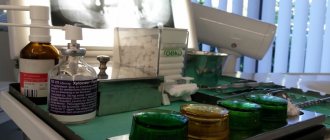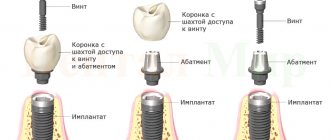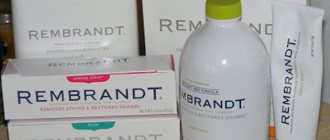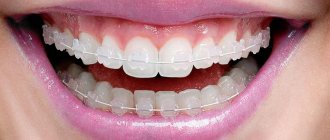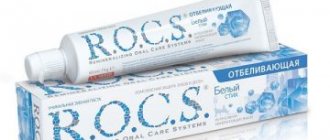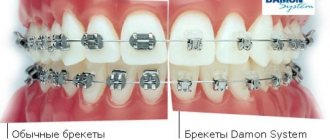When making dental prosthetics in dentistry, various materials and restoration technologies are used. One of the traditional materials, tested for decades, is gold. The qualities of elasticity, durability and strength are indicators that explain this choice.
It is this metal that can provide comfortable chewing of food for a long time and not deform. In addition, it is not an environment in which pathogenic microorganisms develop.
How to clean gold crowns from cement at home
Gold crowns are the most ancient method of dental prosthetics.
Their biggest fans are grandparents, for whom this is not only a concern for health, but also an investment in precious metals. Gold dentures easily compete in the dental services market on a par with modern analogues. What kind of doctor puts dental crowns?
Due to the softness of the metal, it is used in the form of an alloy with alloy metals - silver, platinum, copper. Depending on the percentage of components, the material for making the crown has different characteristics:
- 900 standard – characterized by softness and pliability,
- 750 sample – low level of shrinkage against the background of high elasticity,
- super-TZ is the hardest of the alloys.
The type and purpose of the required structure determines the choice of material. Wear-resistant alloys are not used in dental practice, so in any case the product will be durable and reliable.
Gold is used in the form of an alloy with silver, platinum, copper
Advantages
Gold crowns have many advantages compared to other materials used for prosthetics:
- full compatibility with soft tissues of the oral cavity;
- the absence of any harmful additives in the alloy - as a result, there is no risk of an allergic reaction, irritation and other unpleasant manifestations on the oral mucosa;
- high strength – for the manufacture of crowns, gold of the highest standard is used, which is resistant to any damage;
- due to the softness of the alloy, antagonist teeth are not injured;
- After prosthetics, almost complete “fusion” of the natural unit and the gold crown occurs.
How are dentures made?
If it is assumed that a gold tooth will be installed in the smile area, then the precious metal frame is lined with ceramic mass. Pure gold is not used when casting crowns. To make the prosthesis as resistant to external “attacks” as possible and to hold well, palladium and platinum are added to the alloy.
Recently, designs decorated with stones and gold figurines (as in the photo above) have become especially popular in dentistry. Not long ago, the possibility of prosthetics using removable gold products appeared (they are not installed for medical reasons, but only for aesthetic reasons).
Depending on the manufacturing technology, gold-plated overlay crowns can be cast or stamped. The latter are made from standard blanks - sleeves, adjusted before fixing them onto the tooth stump directly in the dental office, and set on cement mortar. Cast products are formed according to individual wax models; adjustment in the oral cavity is not required (crowns are more precise in manufacturing).
Indications for prosthetics
It is recommended to give preference to gold teeth:
- if necessary, restore the original shape and size of natural units as accurately as possible;
- to correct significant malocclusions, strengthen individual teeth;
- for the purpose of restoration of chewing units (invisible when smiling and talking);
- in the presence of bruxism, as well as bad habits of chewing hard objects, opening bottles with teeth.
The tooth is prepared for subsequent preparation (a picture is taken, caries is treated, the old filling is replaced, the composite is restored on the pin, etc.). Next, injectable local anesthesia is administered and the “working” unit is ground (to the thickness of the crown). After this, the doctor makes impressions of both jaws and sends them to the laboratory to make plaster models of teeth. Based on plaster prototypes, artificial crowns are formed and (if necessary) tried on. The last stage is fixation of the gold prosthesis on the tooth stump using special cement.
Advantages and disadvantages of gold crowns
Let's consider the main advantages :
- Such dentures do not have an abrasive effect on other teeth, thereby preventing their wear.
- Gold itself is beneficial for teeth, the whole body, and the oral cavity, improving its microflora.
- Gold structures are inert to saliva and food composition.
- Dentures do not cause allergies and are completely safe for humans. They will last longer than products made from other metals.
- Teeth are better preserved under crowns; they cope well with the chewing process.
- The structures themselves, made of gold, cannot break or splinter.
Minuses:
- Due to the softness of gold, crowns wear off.
- Making and installing gold structures is expensive.
- They ruin the aesthetic appearance if you replace the front teeth with prosthetics.
What alloys are they made of?
The list of materials that are suitable for the manufacture of such structures includes:
- alloy of chromium and cobalt
- chromium-nickel alloy
- high titanium alloys
- alloys containing precious metals (precious alloys)
Interesting fact! Titanium is resistant to aggressive factors, does not darken and does not provoke the development of allergic reactions, therefore it is often included in alloys for the manufacture of cast dentures. And alloys containing gold in their composition are characterized by ductility, which ensures an accurate fit to the gum.
Solid crowns are also divided into the following types:
- metal coated
- metal without coating
- metal with ceramic lining
- combined bridges
Designs without coating are usually made of polished metal, are low in cost, but are often not suitable for patients due to their unaesthetic appearance. Metal structures coated with gold look more attractive. However, spraying can negatively affect the mucous lining of the oral cavity.
Solid crowns with veneer are covered with ceramic material and look the most aesthetically pleasing. For longevity, recommended care instructions must be followed. A combined prosthesis is made from several metal-ceramic prostheses (which cover the smile area) and from solid crowns.
The benefits of an irrigator when caring for crowns made of zirconium and other materials
The irrigator is ideal for caring for crowns and dental structures. The operating principle of the irrigator is based on a directed pulse of water with adjustable intensity. Such equipment massages the gums and effectively cleans the interdental space. Unlike dental floss, it is impossible to damage soft tissues with an irrigator; there is absolutely no discomfort during such treatment.
You can purchase the irrigator in a stationary or portable version. The second option is slightly inferior in terms of water capacity, but you can take the device with you and care for your oral cavity while traveling.
Deeper cleaning from germs and plaque
Sometimes patients ask the orthopedic dentist how to clean their dentures to disinfect and remove pigmentation and stains. For this purpose, manufacturers of dental hygiene products offer special tablets that can be purchased at the pharmacy. To carry out deep disinfectant cleaning you need:
throw one tablet into the liquid to clean dental structures;
How to install
After making the gold crown, the specialist begins installation. You can insert gold teeth in just a few steps. The approximate procedure is as follows:
- after grinding the tooth, a temporary structure is placed to protect it from destruction and discomfort;
- fitting and correction of the finished crown in the oral cavity is performed;
- the structure is installed and fixed with special cement.
Immediately after installation, you can return to your normal rhythm of life. But to be on the safe side, it is not recommended to eat hot, cold or too hard food for the first few days.
Precautionary measures
Dental gold is not used for dental prosthetics in patients with mental disorders or chronic periodontitis. Contraindications to the installation of gold dentures are the period of pregnancy in women, as well as the patient’s age under 16 years. Naturally, gold prostheses made of gold are also not placed on mammary units. For the first few days after prosthetics, you should refrain from eating hard foods.
In some patients, the adaptation period is associated with certain discomfort - increased sensitivity of the “working” tooth, pain when biting. In a number of clinical cases, the fixing cement is washed out from under the prosthesis - this can lead to the development of local inflammatory processes and caries, and as a result, the crown may simply fall out. In this case, you should contact an orthopedic dentist - he will decide what can be done (remove the remaining cement, replace it with new material, insert the crown in place).
The first question is why?
Believing that these products are undemanding and durable in themselves, even if nothing is done to maintain their functionality, people make one of the most fatal mistakes. Without keeping an eye on them, after some time, they are surprised to discover that the structure has become unusable and needs urgent replacement. However, the cost of prosthetics cannot be called junk, so it is better to take care of the product in a timely manner in order to maximize its service life. But this is not the only reason; it makes sense to consider others:
Prevention of diseases, including infectious ones.
Preservation of supporting teeth (if any).
Eliminating bad breath.
Preservation of normal microflora in the oral cavity.
Neglecting the main postulates can lead to the development of various diseases. Therefore, it is very important to understand the questions of whether, with what and how to clean a plastic denture using folk remedies, how to store the product at home and what paste to use against dark plaque. After all, if the plastic itself does not suffer from non-compliance with standards, then it can quite realistically become a real breeding ground for pathogenic bacteria and other dangerous microorganisms.
Daily care
Structures can be made of various materials, for example, plastic and metal-plastic, nylon and acrylic, polyurethane and others, but they all equally need hygiene every day. There are several simple rules that must be followed so that they last a long time and do not cause health problems for the owner:
It's a good idea to start your morning by brushing your teeth. It makes sense to perform all the necessary manipulations, step by step.
Every time after eating, it is advisable to rinse the structure under running water to completely remove all, even the smallest particles of remaining food. You can brush your teeth, which serve as support teeth, with a regular brush, and your gums can be treated with special rinses.
We wash cement at home
The easiest way to wash cement at home from various surfaces is with the help of special solvents, which can be purchased at a hardware store. However, small stains and stains can be washed away even with folk remedies. In this article we will consider both options in detail.
Solvents
Any solvent for cement necessarily contains a strong acid or abrasive, which has a detrimental effect on the structure of concrete, destroying it. There are also solvents that do not contain acid. The cleaning product also contains inhibitors and auxiliary components responsible for protecting other surfaces from the action of acid.
As soon as you spray the selected solvent onto the concrete surface, the cement will immediately begin to foam, which is a consequence of the action of the acid. By corroding the structure of the building material, the solvent turns cement into a paste that is very easy to remove from almost any surface. Most often, traces of cement are removed in this way on glass, plastic frames, paving stones or various floor coverings. The following main characteristics of any solvent for cement can be distinguished:
- despite the fact that the solvent contains a strong acid, this substance is absolutely safe for use even in a closed and poorly ventilated area, since the solvent does not evaporate and does not release harmful fumes into the air;
- on the label of any solvent you can find information that the substance is not flammable, so this product will not cause a fire;
- the acid contained in the solvent has a detrimental effect only on the composition of the cement; this substance is completely harmless for paint and varnish surfaces, so you can safely clean parquet, linoleum or decorative items with it;
- there is a strict recommendation to work with cement solvent in a respirator, but this product does not release caustic substances that affect the mucous membrane;
- If you are working with solvent outside, for example, cleaning paving stones from cement stains, you should not worry that the liquid has got on the soil, since the solvent will not harm organic matter and will dissolve very quickly.
Price
The final price of the prosthesis depends on how much the crown weighs and the current cost of 1 gram of gold at the time of the procedure. How much prosthetics will cost is determined by:
- the complexity of the surgical intervention;
- pricing policy of the selected clinic;
- the total cost of the crown itself (depending on the country, manufacturer, etc.).
So, despite the existence of a large number of alternative materials for the manufacture of dentures in modern dentistry, gold crowns are still popular. They are placed mainly on chewing teeth, because these products are durable, wear-resistant, and ideally “fit” into the natural microflora of the oral cavity. The main disadvantages of gold crowns are their dubious aesthetic properties and the high cost of both the material itself and the prosthetics.
4 ways to clean gold crowns.
Gold crowns were very popular during the Soviet Union, they showed the wealth of their owner. They are still used today, although not as often. Gold has always been a harmless material that protected teeth from excessive stress and wear.
Manufacturers of gold prostheses use 900-grade precious metal, which has virtually no impurities. The structure must be adjacent to the treated tooth and installed using a special cement composition. In order for a gold crown to last as long as possible, you must adhere to a number of rules that your dentist will tell you.
If for some reason the crown breaks, then it can be profitably sold for gold. There is no need to store such products at home, because they can be melted into any decoration.
Owners of gold crowns need to understand that they fall off along with the cement mortar that held the crown. Therefore, you need to know how to properly prepare a gold item for purchase so that the weight is calculated correctly and precious grams are not lost. To do this, you need to clean the precious metal crowns.
The following methods can be used to remove all excess from the crowns:
- Make a solution of ammonia, soap, hydrogen peroxide. Dip a gold crown into the liquid and heat it directly in the container. Wait about five minutes, brush, rinse in water and wipe;
- You can use a special solution to disinfect impressions, which will remove the cement mortar. It can be purchased at dental stores;
- A small hammer will remove the cement from the crown, and the remaining small particles should be burned out and removed with tweezers. All that remains is to hold the gold item in hydrochloric acid (15%) to give it maximum whiteness. Carry out this procedure in a ventilated area or outside.
All these methods can be done at home.
But the best option is to use the services of professional dentists, who will clean the crown and leave only pure gold. They usually burn the crowns over a fire and then lower them into a solution of hydrochloric acid.
If you have crowns lying around, then it’s time to get rid of them and donate them to a gold buyer. And the money received can be spent on a new crown or on other needs, for example, on jewelry.
Cleaning gold crowns from teeth.
If installed correctly and regularly cleaned, gold crowns will last at least 15 years. Prosthetics is the ability to make the absence of one or more incisors invisible thanks to artificial replacement. Along with ceramic, plastic and metal-plastic structures, metal products remain popular.
How to clean gold crowns
The standard cleaning method involves using dental floss or chewing gum after each meal, as well as thoroughly rinsing the mouth. If not properly maintained, the element may fall out or become damaged.
If a tooth falls out, you should not chew on an open tooth, because this may lead to its destruction. You should perform normal oral hygiene and contact your dentist as soon as possible.
How long can the product be used?
Gold crowns have a long service life - 15-20 years. Careful attitude and appropriate hygienic care can extend it to 25. But again, you need to look at the condition of both the supporting and opposing teeth. Nothing will happen to the crown itself during this time, but the rest, the living tissues, gradually fail. This explains the need to replace the prosthesis.
Despite the numerous advantages of using gold crowns in dental prosthetics, today dentistry still offers more advantageous options for crowns. For example, those made on the basis of zirconium dioxide or metal-ceramic on a gold basis. Such dentures will not only be strong and durable, but will also add naturalness and aesthetics to your smile.
Author: Sambuev B. S. (Thank you for your help in writing the article and the information provided)
Adjustment period: main problems
Immediately after installation, you should not drink or eat for about 2 hours (the dentist will indicate a more precise time, since the duration of the period of abstinence depends on what type of cement was used for fixation). There are no special requirements regarding lifestyle changes.
In some cases, while getting used to the structure, the patient may encounter problems such as pain and discomfort, and increased tooth sensitivity. You must inform your dentist who performed the installation about any unusual or unpleasant sensations. It may be necessary to correct the position of the crown, or the situation is temporary, and the use of special products (rinse aid, paste) will be sufficient.
It will take some time to get used to, during which it is advisable to avoid eating solid foods so as not to accidentally damage your cheek or tongue.

